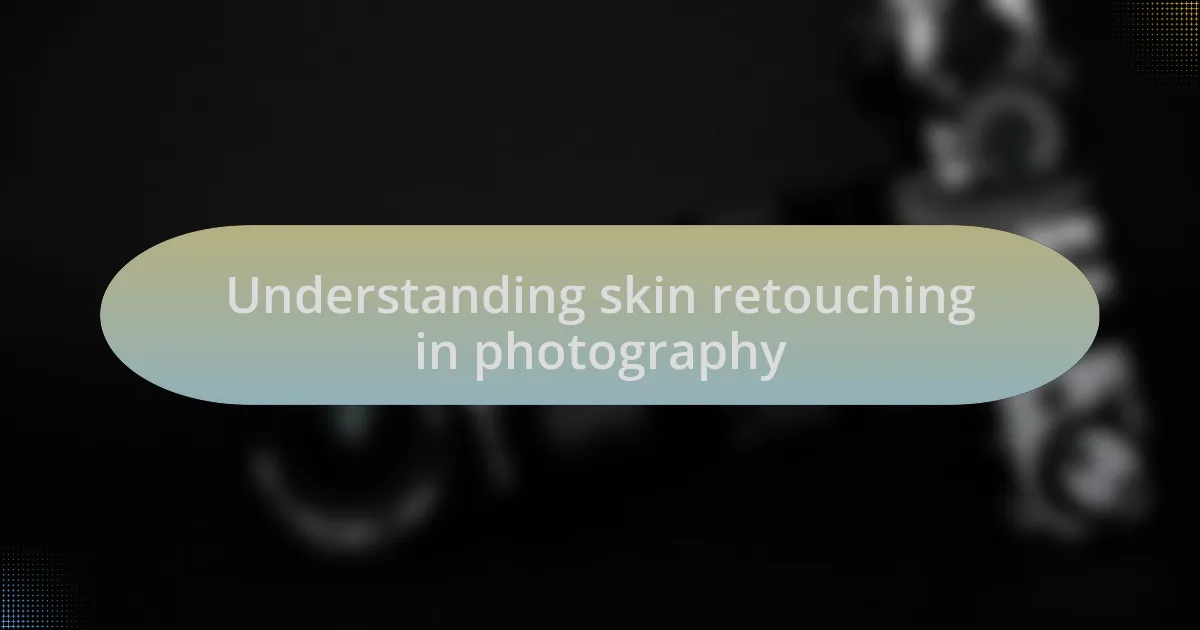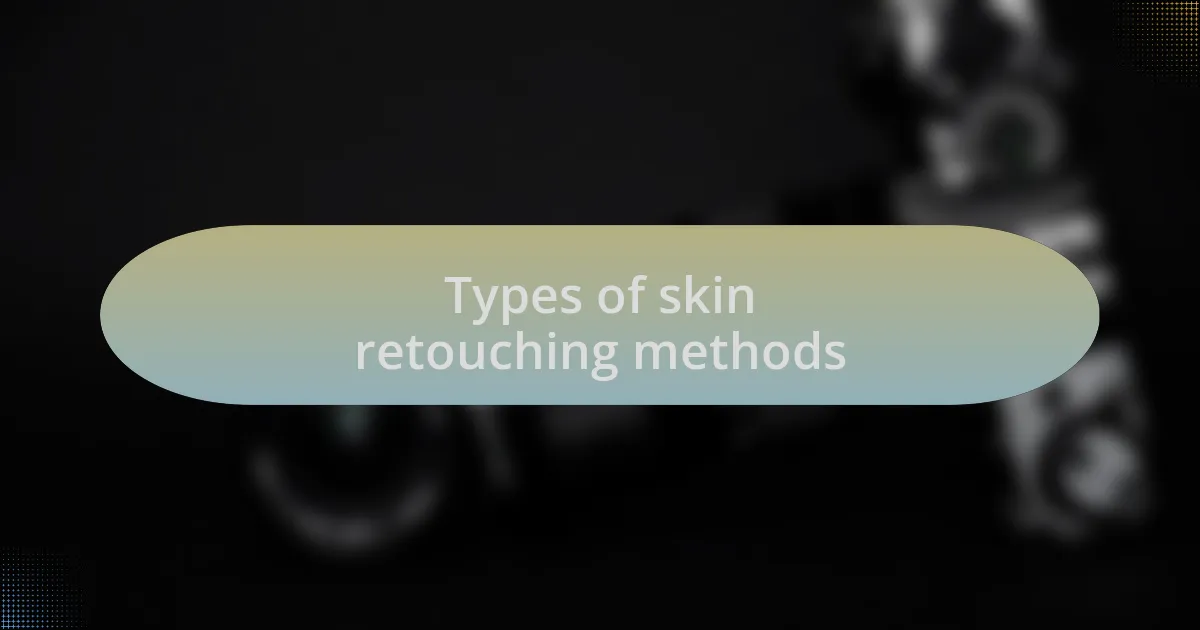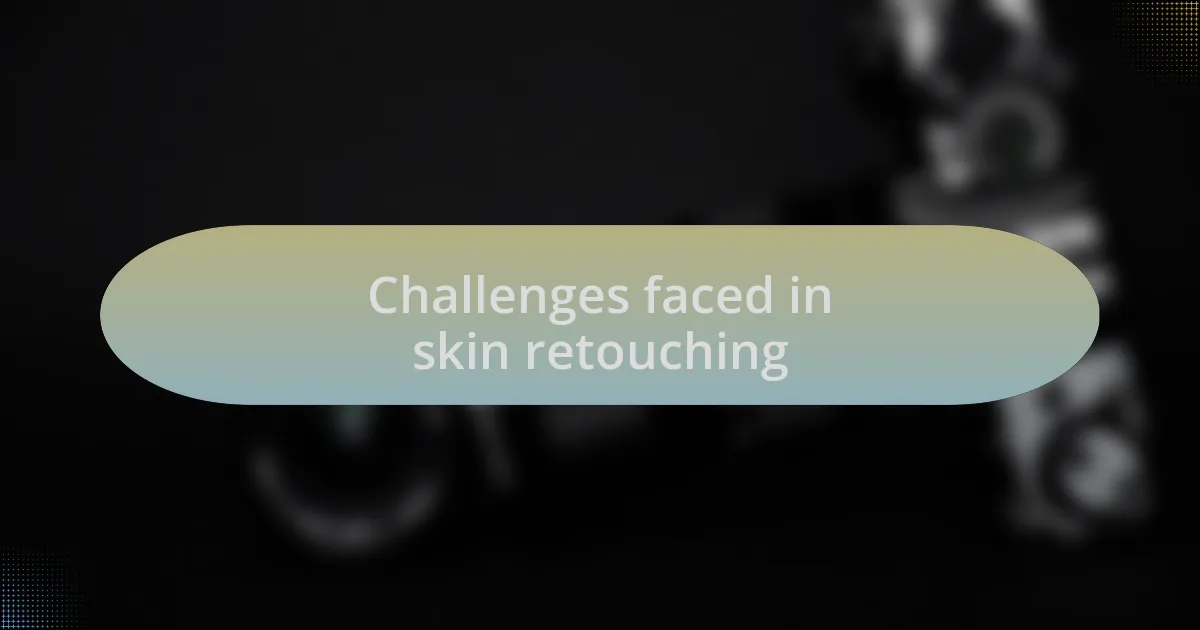Key takeaways:
- Skin retouching balances enhancing natural beauty with authenticity, avoiding over-polishing that creates emotional distance.
- Retouching techniques like frequency separation, healing brush, and dodge and burn offer unique approaches to maintain skin texture while enhancing beauty.
- Challenges include finding the right balance between realism and enhancement, managing diverse skin tones, and time constraints that impact quality.

Understanding skin retouching in photography
Skin retouching in photography is not just about creating a flawless appearance; it’s about enhancing the subject’s natural beauty while maintaining authenticity. I remember my first experience with retouching a portrait. I was torn between removing blemishes for a polished look and preserving the unique character of my subject’s skin. That struggle really opened my eyes to the delicate balance between idealism and realism.
What’s fascinating is how much skin retouching can influence the viewer’s perception of a photograph. Have you ever noticed how some images evoke an emotional response due to the way skin texture is presented? I find that a soft, delicate touch can elicit warmth and intimacy, making the viewer feel a connection with the subject. Conversely, an overdone retouch can create a barrier, making them seem unapproachable or even artificial.
It’s important to remember that the goal of skin retouching should be to celebrate individuality rather than erase it. I often ask myself, “What story am I telling through this photograph?” Prioritizing the subject’s story allows for a more meaningful representation. Each skin flaw or unique mark carries the history of its owner, and when retouched thoughtfully, it can highlight the beauty in those imperfections.

Importance of skin retouching techniques
When I think about the importance of skin retouching techniques, what often comes to mind is the power they hold in shaping a viewer’s narrative. For instance, during a wedding shoot I did, I carefully retouched the bride’s skin, striking that fine balance where she sparkled without losing the essence of who she is. That approach not only made her feel confident on her special day but also allowed the images to radiate joy and authenticity.
It’s intriguing how a simple retouch can convey emotions that resonate with viewers. I once experimented with varying levels of retouching on a series of portraits, and I noticed that the softer, more natural edits prompted feedback that was far more heartfelt. People commented on the subjects’ authenticity, saying they felt as though they could relate to them. Isn’t it fascinating how a technique can bridge the gap between the subject and the audience?
I believe that skin retouching isn’t just a technical choice; it’s an artistic statement about beauty standards. When I first delved into retouching, I saw it merely as a way to enhance looks. However, through practice, I’ve learned that it can also be a method to challenge societal norms. Each decision I make in retouching reflects my values on beauty and self-acceptance. It’s a subtle yet powerful force that can foster a positive dialogue about authenticity in photography.

Types of skin retouching methods
There are various methods for skin retouching, and each offers a unique approach to enhancing skin texture and tone. One popular technique is frequency separation, which I often rely on. This method separates the texture from the color, allowing me to smooth out skin while preserving the natural details. I remember the first time I used it; the result was so subtle yet effective that it transformed my entire perspective on skin retouching.
Another method worth mentioning is the use of the healing brush tool, which I find particularly useful for quick fixes. I recall a photo shoot where my subject had a few blemishes that needed attention. By using the healing brush, I was able to effortlessly blend those imperfections away, and the subject remarked on how it made her feel like her true self was shining through, bolstering her confidence for the image.
Lastly, dodge and burn is a classic approach that can create beautiful depth and dimension in skin retouching. I recall experimenting with this technique on a portrait of a friend, emphasizing her cheekbones and enhancing the light in her eyes. The transformation was incredible, bringing out the natural beauty in a way that felt both artistic and respectful. How often do we overlook the power of subtle shading in our images?

Challenges faced in skin retouching
When it comes to skin retouching, one of the biggest challenges I face is striking the right balance between realism and enhancement. I remember a specific image from a recent shoot where I overdid the smoothing process, leaving the subject’s skin looking oddly plastic. Have you ever struggled with this? It can be disheartening to realize that, in the pursuit of perfection, we sometimes lose the essence of our subjects.
Another hurdle is managing skin tone variations, especially in diverse skin types. I once worked with a model who had beautiful, rich hues, but there was a patchiness that needed attention. While attempting to correct it, I found myself battling with not making the color appear flat or unnatural. That experience taught me that a careful approach to color grading is just as crucial as the retouching itself.
Furthermore, time constraints can complicate the retouching process. During busy shoots, I often find myself racing against the clock, which can lead to less attention to detail. I distinctly remember a session where I felt the pressure to deliver quickly, and I ended up missing a few spots that I would have otherwise fixed. It’s a reminder that even in the fast-paced world of photography, quality should never take a backseat to speed. Have you ever felt the weight of time affecting your creative choices? It’s something we all navigate in our craft.